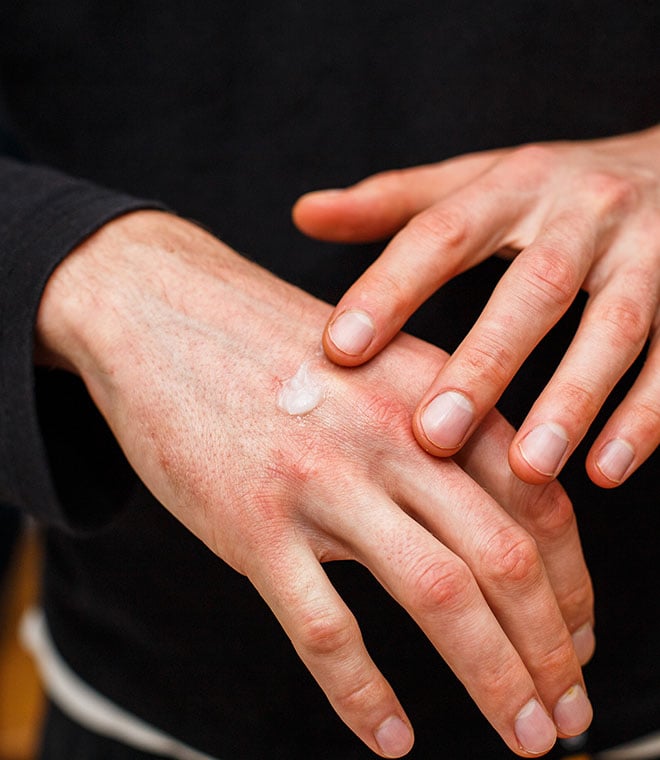Health
11 tips to keep indoor allergies at bay
By Jenilee Matz, MPH Apr 18, 2025 • 7 min
With allergies, the body’s immune system mistakes a normally harmless substance as a threat and causes a reaction. Specifically, the cells release histamine, a chemical produced by the immune system, in an effort to protect the body from the trigger, which is called an allergen. If you experience symptoms of indoor allergies, there are ways to address the problem.
Can you be allergic to dust?
Yes, you can be allergic to dust. It can be found inside and outside of your home in mold, tiny pollen particles, detergents, fabric fibers and pet dander.
What are dust mites?
Dust mites are microscopic organisms that feed off flakes of dead human skin that naturally slough off. People are usually allergic to dust mite body parts and droppings. Roughly four out of five homes have dust mites in at least one bed. Dust mites don’t bite or spread disease. However, some people may have more allergy symptoms or worsening asthma due to dust mites.
What causes dust mites?
Dust mites live and multiply in warm, humid spots in your home. Living mites, dead mites and their feces can cause allergy symptoms. Particles of dust mites are often found on pillows, mattresses, carpets and upholstered furniture. The particles drift into the air when someone vacuums, walks on a carpet or shifts bedding. After they’re disturbed, they settle again on objects.
Dust and dander allergy
Dust allergies are common. Dust mites are the most common trigger of year-round allergies and asthma. Household dust can also contain other allergens including pet dander, hair, fur and feathers, cockroaches, mold and pollen (which comes in from the outside through windows).
Indoor allergy symptoms
You can have allergy symptoms when you inhale or come into contact with allergens. Although most exposure occurs while sleeping, people with indoor allergies often notice an increase in symptoms right after vacuuming, sweeping or dusting. This occurs because cleaning disturbs dust particles, making them easier to inhale and more likely to trigger symptoms. Symptoms of indoor allergies can include:
- Sneezing
- Runny nose
- Stuffy nose
- Itchy, red or watery eyes
- Itchy skin
- Itchy mouth, throat or nose
- Postnasal drip
- Cough
Dust mite allergies can make eczema worse, causing an itchy rash. Dust mite allergies can also trigger asthma symptoms in some people with asthma, causing symptoms such as:
- Trouble breathing, or a whistling or wheezing sound when you breathe out
- Chest tightness or pain
- Difficulty sleeping due to shortness of breath, coughing or wheezing
Removing allergens from your home
Consider making changes to your home and routine to help reduce dust mites and other indoor allergens. Keep in mind that your house doesn’t have to be visibly dirty to cause allergy symptoms. Dust mite particles are very tiny and can be difficult to remove. However, regular cleaning goes a long way.
- Eliminate fabrics from your home that you cannot easily wash in hot water, such as curtains, blinds, upholstered furniture, down-filled pillows and bedding.
- Cover mattresses and pillows with zippered, dustproof cases. These covers are made using materials with pores that are too small to let dust mites in.
- Wash your sheets and blankets each week in hot water that’s at least 130 degrees Fahrenheit, and then dry them in a hot dryer. Wash throw rugs regularly in hot water.
- Use a dehumidifier to keep humidity levels in your home ideally below 50%. Dust mites and mold thrive in humid conditions, so do not use a humidifier.
- Clean your house often using a special vacuum cleaner that’s equipped with a high-efficiency particulate air (HEPA) filter. A HEPA filter is a mechanical air filter that traps debris, including dust, and prevents it from getting back into the air. Note that vacuuming doesn’t remove all dust mites and waste since they can be deep in the carpet. However, regular vacuuming will remove surface dust. When vacuuming, individuals with allergies should consider leaving the house to avoid any airborne allergens. In addition, consider installing a high-efficiency filter in your central furnace and air conditioning unit to reduce the number of allergens that circulate throughout your home. Replace the filter according to manufacturer’s recommendations.
- Wear a mask when cleaning to reduce the amount of dust you breathe in.
- Wipe down surfaces with a damp cloth regularly, including flat surfaces, hard blinds, window ledges, picture frames and other decorative accents. Clean all non-carpeted floors with a damp mop weekly.
- Place items that collect dust in plastic bins, such as books, magazines, toys, games and stuffed animals.
- Wash your hands well after petting your dog or cat. Try to keep pets out of your bedroom, and vacuum carpets often.
- Keep windows closed and use the air conditioning during pollen season. Be sure to clean mold and condensation from your windows and sills regularly.
- Protect your home from cockroaches. Like dust mites, cockroach feces, saliva and shedding body parts can trigger allergy symptoms when their particles move through the air. Keep your garbage cans tightly sealed, cover all unrefrigerated foods and clean up crumbs promptly. If you have a cockroach problem, use traps or contact a pest control service.
Talk with your healthcare provider if you think you might have indoor allergies. They can help determine the exact cause of your symptoms and recommend a treatment plan.
Updated April 2025.
Sources:
- https://www.epa.gov/indoor-air-quality-iaq/biological-pollutants-impact-indoor-air-quality
- https://www.mayoclinic.org/diseases-conditions/allergies/in-depth/allergy/art-20049365
- https://acaai.org/news/do-you-have-the-winter-sniffles-5-ways-you-can-manage-indoor-winter-allergies/
- https://medlineplus.gov/ency/patientinstructions/000487.htm
- https://www.lung.org/clean-air/at-home/indoor-air-pollutants/dust-mites
- https://www.lung.org/clean-air/at-home/indoor-air-pollutants/cockroaches
- https://www.merckmanuals.com/home/immune-disorders/allergic-reactions-and-other-hypersensitivity-disorders/year-round-allergies
- https://www.ncbi.nlm.nih.gov/books/NBK447112/
- https://medlineplus.gov/ency/article/000141.htm
- https://allergyasthmanetwork.org/news/hepa-help-hype/
- https://nationaleczema.org/blog/dust-mites/
-symptoms-and-seasonal-allergies/CH_Difference_COVID_Allergies_330x380.jpg)


